Modelling the Present and Future Water Level and Discharge of the Tidal Betna River
Abstract
:1. Introduction
2. Materials and Methods
2.1. Study Area
2.2. Hydrodynamic Model Set Up
2.3. Bathymetric Survey and Mesh Generation
2.4. Meteorological and Hydrodynamic Data
2.5. Calibration, Validation and Sensitivity Analysis
2.6. Future Scenario Development
3. Results
3.1. Model Calibration, Validation and Sensitivity Analysis
3.2. Future Projections
4. Discussion
5. Conclusions
- increased precipitation and SLR are expected in the Betna River basin in the near and far future under both RCP 4.5 and RCP 8.5;
- in RCP 8.5, water level and discharge in the Betna River are expected to increase up to 16 and 13% for the 2040s, and up to 23 and 21% for the 2090s, respectively;
- in RCP 4.5, although the expected increase in river discharge is relatively low (i.e., between 7 and 16%), the increased discharge combined with an increased water level is likely to cause major floods in the Betna River basin;
- the modelling results suggest that during the dry season, a small decrease in discharge (up to 2%) is expected for the 2090s;
- SLR explains a larger part of the future increase in water level than increasing upstream discharge; and
- in the future, the duration above the current flood danger level and of the extreme discharge events is expected to increase by half a month (per year) in the 2040s and by more than one month in the 2090s, causing prolonged inundation in the river basin, particularly during the monsoon.
Author Contributions
Funding
Acknowledgments
Conflicts of Interest
References
- Webster, T.; McGuigan, K.; Collins, K.; MacDonald, C. Integrated river and coastal hydrodynamic flood risk mapping of the lahave river estuary and town of Bridgewater, Nova Scotia, Canada. Water 2014, 6, 517–546. [Google Scholar] [CrossRef]
- Ahmed, A.U. Bangladesh Climate Change Impacts and Vulnerability: A Synthesis, Climate Change Cell Department of Environment, Govt. of Bangladesh. 2006. Available online: https://www.Preventionweb.Net/files/574_10370.Pdf (accessed on 25 March 2017).
- CEGIS. Environmental Impact Assessment of Re-Excavation of Betna River in Satkhira District for Removal of Drainage Congestion; Bangladesh Water Development Board: Dhaka, Bangladesh, 2013; pp. 1–182. [Google Scholar]
- Asian Development Bank (ADB). Adapting to Climate Change: Strengthening the Climate Resilience of the Water Sector Infrastructure in Khulna, Bangladesh; Asian Development Bank: Mandaluyong City, Philippines, 2011; pp. 1–40. [Google Scholar]
- Karim, M.F.; Mimura, N. Impacts of climate change and sea-level rise on cyclonic storm surge floods in bangladesh. Glob. Environ. Chang. 2008, 18, 490–500. [Google Scholar] [CrossRef]
- IPCC. Summery for policymakers. In Climate Change 2014: Impacts, Adaptation, and Vulnerability. Part A: Global and Sectoral Aspects; Field, C.B., Barros, V.R., Dokken, D.J., Mach, K.J., Mastrandrea, M.D., Bilir, T.E., Chatterjee, M., Ebi, K.L., Estrada, Y.O., Genova, R.C., et al., Eds.; Contribution of Working Group II to the Fifth Assessment Report of the Intergovernmental Panel on Climate Change; Cambridge University Press: Cambridge, UK; New York, NY, USA, 2014; pp. 1–32. [Google Scholar]
- Mohammed, K.; Islam, A.S.; Islam, G.T.; Alfieri, L.; Bala, S.K.; Khan, M.J.U. Extreme flows and water availability of the brahmaputra river under 1.5 and 2 °C global warming scenarios. Clim. Chang. 2017, 145, 159–175. [Google Scholar] [CrossRef]
- Bandudeltas. Baseline Study on Climate Change in Bangladesh Delta Plan 2100 Project: Coast and Polder Issues, Planning Commision, Government of Bangladesh; Bandudeltas: Dhaka, Bangladesh, 2015. [Google Scholar]
- Jin, L.; Whitehead, P.; Sarkar, S.; Sinha, R.; Futter, M.; Butterfield, D.; Caesar, J.; Crossman, J. Assessing the impacts of climate change and socio-economic changes on flow and phosphorus flux in the ganga river system. Environ. Sci. Process. Impacts 2015, 17, 1098–1110. [Google Scholar] [CrossRef] [PubMed]
- Kuchar, L.; Iwański, S. A modeling framework to assess the impact of climate change on river runoff. Meteorol. Hydrol. Water Manag. 2014, 2, 49–63. [Google Scholar] [CrossRef]
- Whitehead, P.; Barbour, E.; Futter, M.; Sarkar, S.; Rodda, H.; Caesar, J.; Butterfield, D.; Jin, L.; Sinha, R.; Nicholls, R. Impacts of climate change and socio-economic scenarios on flow and water quality of the ganges, brahmaputra and meghna (GBM) river systems: Low flow and flood statistics. Environ. Sci. Process. Impacts 2015, 17, 1057–1069. [Google Scholar] [CrossRef] [PubMed]
- Ghosh, S.; Dutta, S. Impact of climate change on flood characteristics in brahmaputra basin using a macro-scale distributed hydrological model. J. Earth Syst. Sci. 2012, 121, 637–657. [Google Scholar] [CrossRef]
- Apurv, T.; Mehrotra, R.; Sharma, A.; Goyal, M.K.; Dutta, S. Impact of climate change on floods in the brahmaputra basin using CMIP5 decadal predictions. J. Hydrol. 2015, 527, 281–291. [Google Scholar] [CrossRef]
- Alam, R.; Islam, M.S.; Hasib, M.R.; Khan, M.Z.H. Characteristics of hydrodynamic processes in the meghna estuary due to dynamic whirl action. IOSRJEN 2014. [Google Scholar] [CrossRef]
- IWM. Feasibility Study for Drainage Improvement of Polder 1, 2, 6–8 by Mathematical Modelling under the Satkhira District; Institute of Water Modelling: Dhaka, Bangladesh, 2014; pp. 1–184. [Google Scholar]
- Hossain, A.N.H.A. Integrated Flood Management: Case Study Bangladesh; Bangladesh Water Development Board (BWDB): Dhaka, Bangladesh, 2003; pp. 1–14. [Google Scholar]
- Islam, M.M.M.; Hofstra, N.; Islam, M.A. The impact of environmental variables on faecal indicator bacteria in the betna river basin, Bangladesh. Environ. Process. 2017, 4, 319–332. [Google Scholar] [CrossRef]
- DHI. Mike 21 and Mike 3 Flow Model FM; MIKE by DHI: Horsholm, Denmark, 2011. [Google Scholar]
- Uddin, M.; Alam, J.B.; Khan, Z.H.; Hasan, G.J.; Rahman, T. Two dimensional hydrodynamic modelling of northern bay of bengal coastal waters. Comput. Water Energy Environ. Eng. 2014, 3, 140–151. [Google Scholar] [CrossRef]
- Cronshey, R.G.; Roberts, R.T.; Miller, M. Urban Hydrology for Small Watersheds. In Procedding of the Specialty Conference, Hydrauolics and Hydrology in the Small Computer Age. Hydrology Division/ASCE, Lake Buena Vista, FL, USA, 12–17 August 1985; Waldrop, W.R., Ed.; American Society of Civil Engineers: New York, NY, USA, 1985. [Google Scholar]
- Moriasi, D.N.; Arnold, J.G.; Van Liew, M.W.; Bingner, R.L.; Harmel, R.D.; Veith, T.L. Model evaluation guidelines for systematic quantification of accuracy in watershed simulations. Trans. ASABE 2007, 50, 885–900. [Google Scholar] [CrossRef]
- Christensen, N.S.; Lettenmaier, D.P. A multimodel ensemble approach to assessment of climate change impacts on the hydrology and water resources of the colorado river basin. Hydrol. Earth Syst. Sci. Discuss. 2007, 11, 1417–1434. [Google Scholar] [CrossRef]
- Taylor, K.E.; Stouffer, R.J.; Meehl, G.A. An overview of CMIP5 and the experiment design. Bull. Am. Meteorol. Soc. 2012, 93, 485–498. [Google Scholar] [CrossRef]
- Liu, C.; Hofstra, N.; Leemans, R. Preparing suitable climate scenario data to assess impacts on local food safety. Food Res. Int. 2015, 68, 31–40. [Google Scholar] [CrossRef]
- Billah, M.; Rahman, M.M.; Islam, A.K.M.S.; Islam, G.M.T.; Bala, S.K.; Paul, S.; Hasan, M.A. Impact of climate change on river flows in the Southwest region of Bangladesh. In Proceedings of the 5th International Conference on Water & Flood Management (ICWFM-2015), Dhaka, Bangladesh, 6–8 March 2015. [Google Scholar]
- Elshemy, M.; Khadr, M. Hydrodynamic impacts of egyptian coastal lakes due to climate change-example Manzala Lake. Int. Water Technol. J. 2015, 5, 235–246. [Google Scholar]
- Kay, S.; Caesar, J.; Wolf, J.; Bricheno, L.; Nicholls, R.; Islam, A.S.; Haque, A.; Pardaens, A.; Lowe, J. Modelling the increased frequency of extreme sea levels in the ganges–brahmaputra–meghna delta due to sea level rise and other effects of climate change. Environ. Sci. Process. Impacts 2015, 17, 1311–1322. [Google Scholar] [CrossRef] [PubMed]
- Dasgupta, S.; Kamal, F.A.; Khan, Z.H.; Choudhury, S.; Nishat, A. River Salinity and Climate Change: Evidence from Coastal Bangladesh; World Bank Policy Research Working Paper; World Bank Group: Washington, DC, USA, 2014. [Google Scholar]
- Zaman, A.; Molla, M.; Pervin, I.; Rahman, S.M.; Haider, A.; Ludwig, F.; Franssen, W. Impacts on river systems under 2 °C warming: Bangladesh case study. Clim. Serv. 2017, 7, 96–114. [Google Scholar] [CrossRef]
- Kirby, J.; Mainuddin, M.; Mpelasoka, F.; Ahmad, M.; Palash, W.; Quadir, M.; Shah-Newaz, S.; Hossain, M. The impact of climate change on regional water balances in Bangladesh. Clim. Chang. 2016, 135, 481–491. [Google Scholar] [CrossRef]
- Mirza, M.M.Q.; Warrick, R.; Ericksen, N. The implications of climate change on floods of the ganges, brahmaputra and meghna rivers in Bangladesh. Clim. Chang. 2003, 57, 287–318. [Google Scholar] [CrossRef]
- Kan, G.; He, X.; Ding, L.; Li, J.; Liang, K.; Hong, Y. Study on applicability of conceptual hydrological models for flood forecasting in humid, semi-humid semi-arid and arid basins in China. Water 2017, 9, 719. [Google Scholar] [CrossRef]
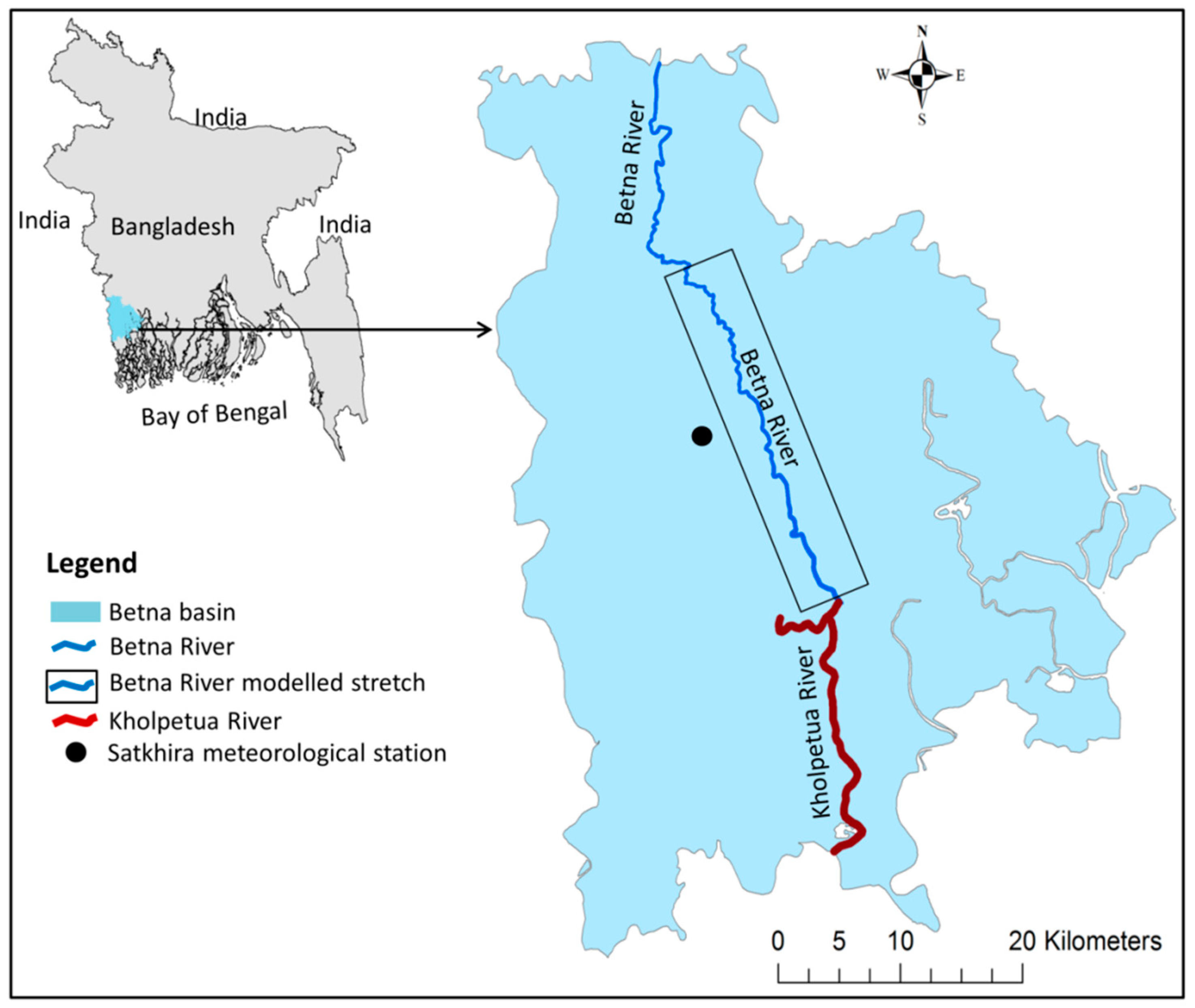
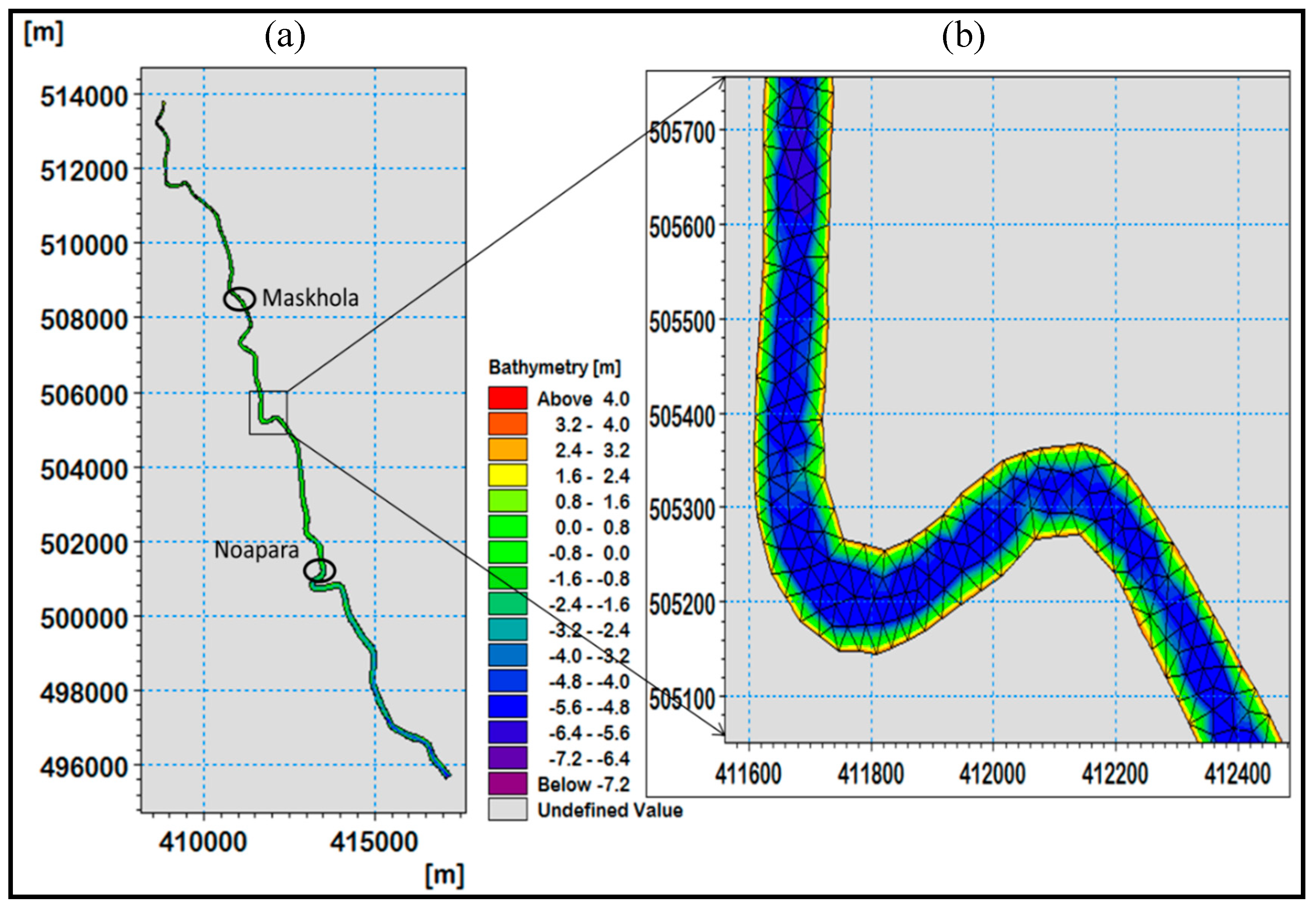

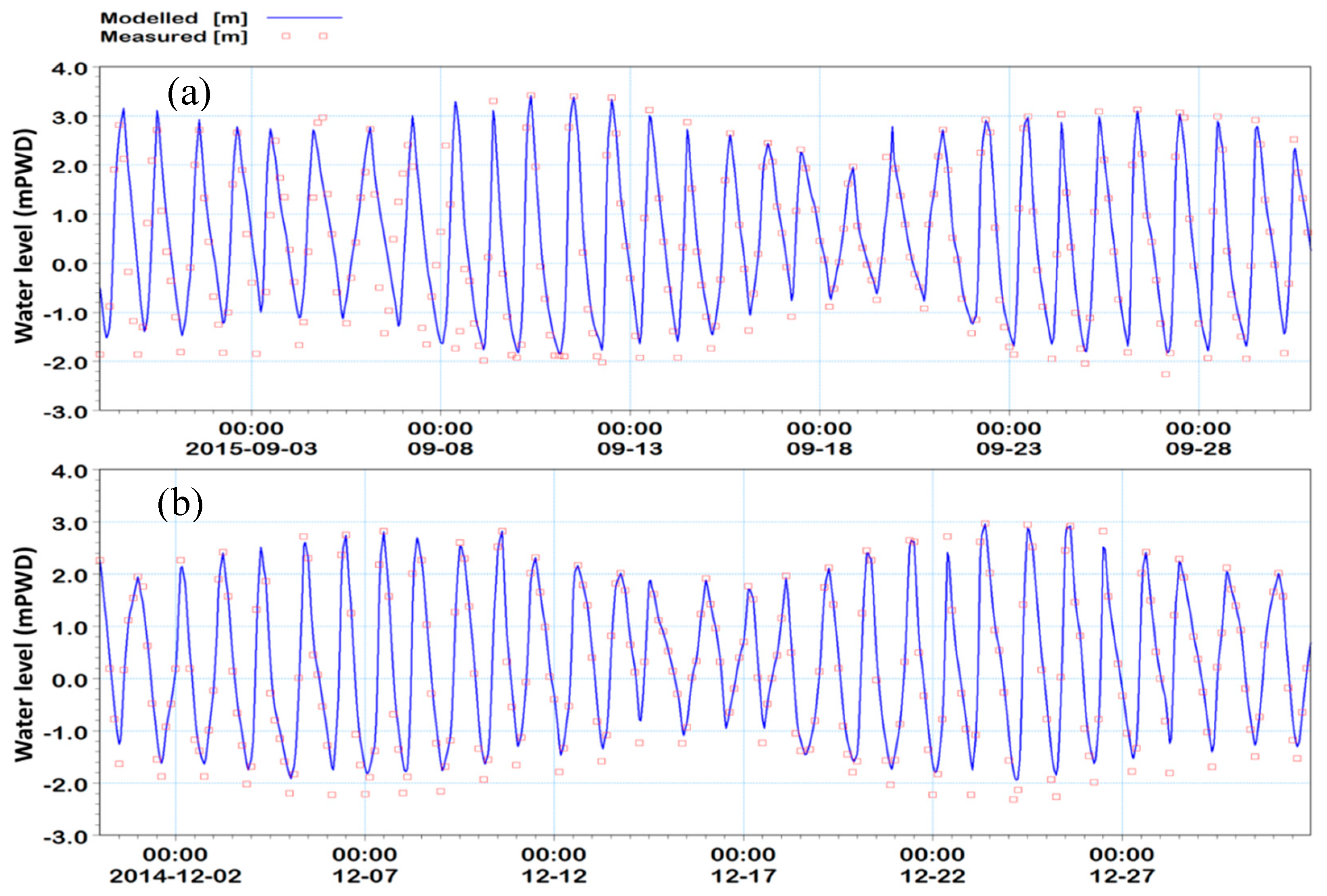
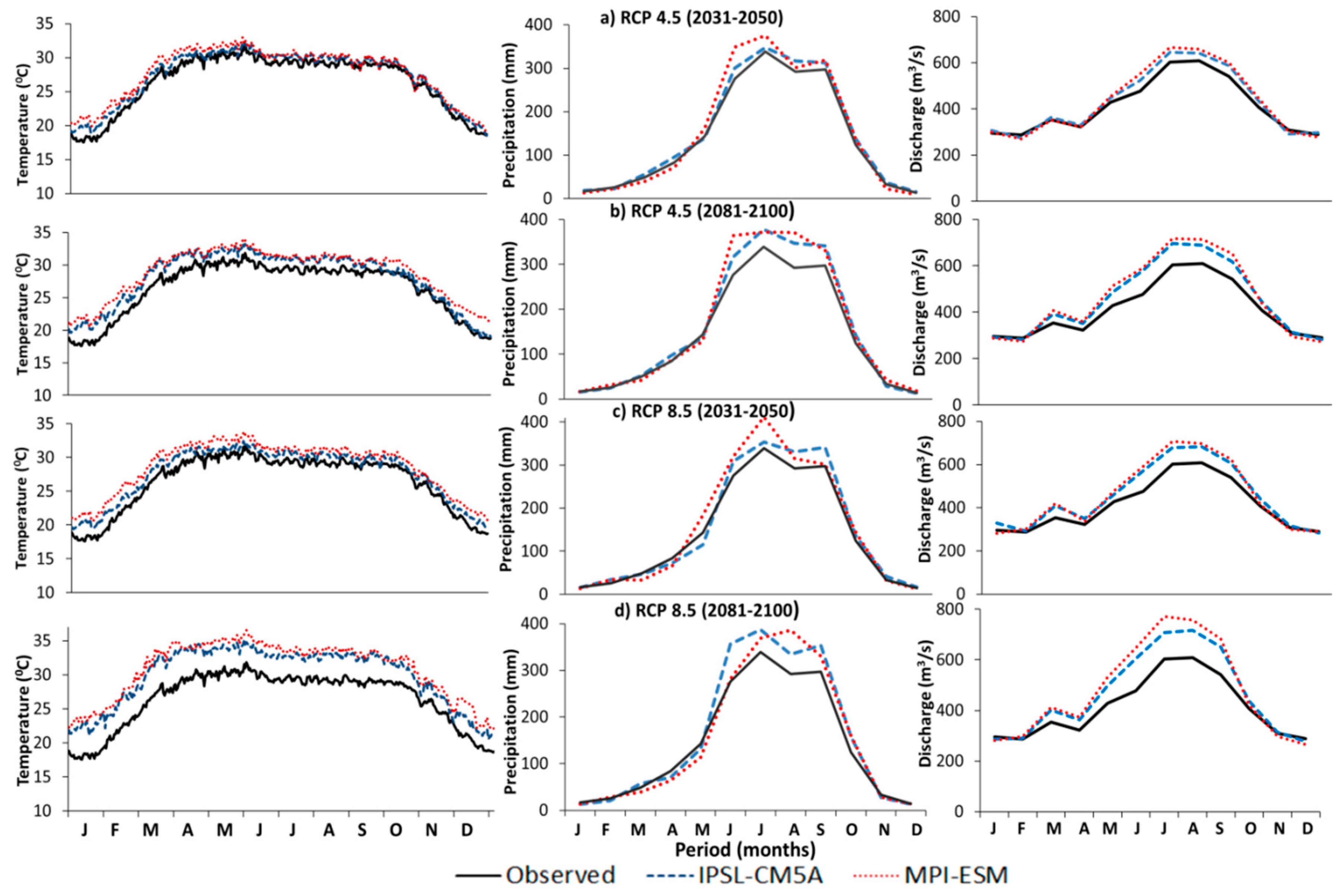
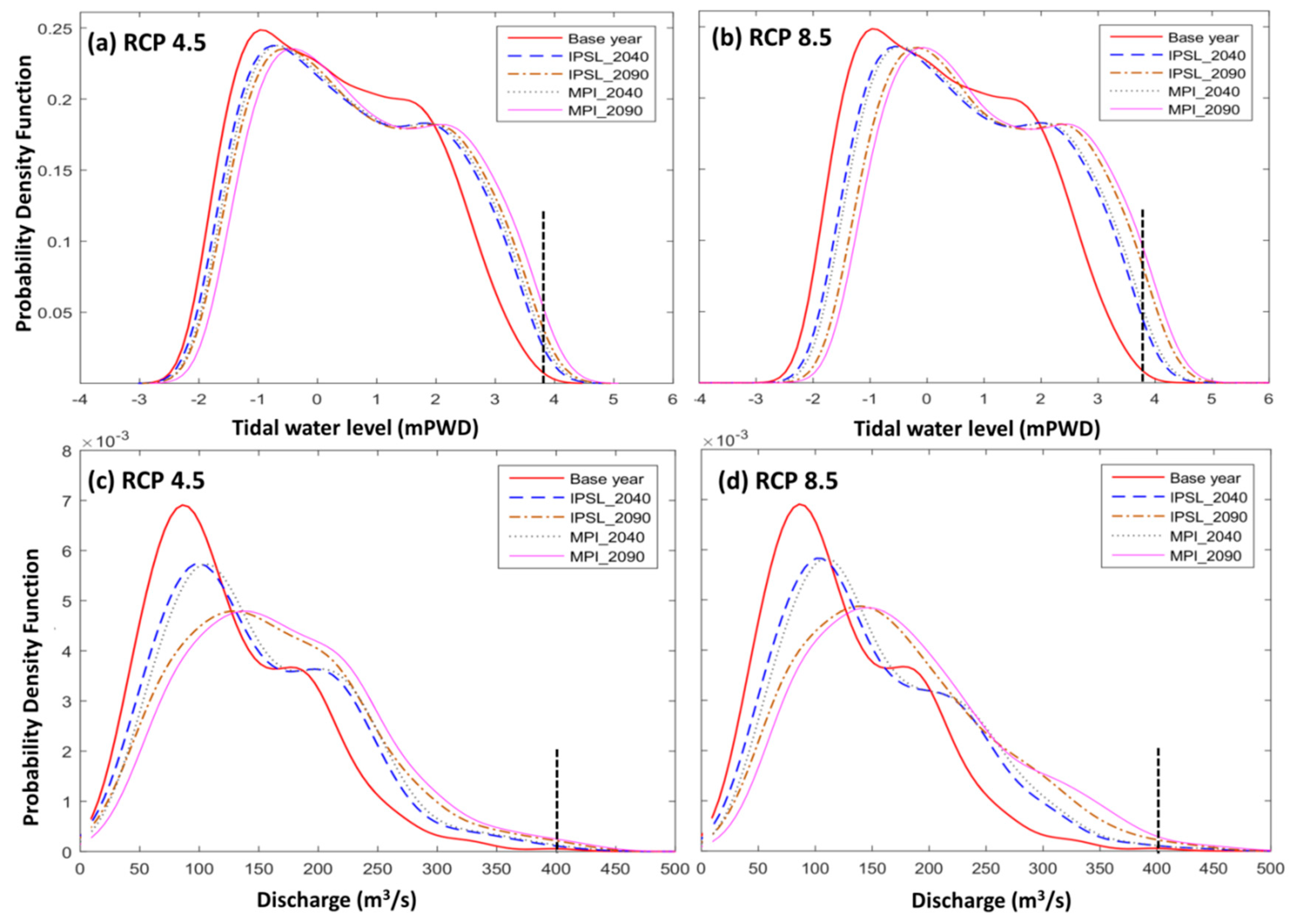
| Data Type | Resolution | Period | Location | Source |
|---|---|---|---|---|
| River bathymetry | Cross-section 400–500 m | 2012 | Modelled stretch | IWM a |
| Water level for calibration period | 0.5 h | 2012 | Maskhola, Noapara and lower boundary | IWM a |
| Water level for validation period | 3 h | 2014–2015 | Near Noapara and lower boundary | BWDB b |
| Discharge for calibration period | 0.5 h | 2012 | Near Noapara and upper boundary | IWM a |
| Discharge for validation period | 1 week | 2014–2015 | Near upper boundary | BWDB b |
| Precipitation | 1 day | 2012–2015 | BMD Satkhira | BMD c |
| Air temperature | 1 day | 2012–2015 | BMD Satkhira | BMD c |
| Wind speed and direction | 3 h | 2012–2015 | BMD Satkhira | BMD c |
| Relative humidity | 1 day | 2012–2015 | BMD Satkhira | BMD c |
| Parameter Type | Formulation | Calibrated Value | Note |
|---|---|---|---|
| Horizontal eddy viscosity | Smagorinsky formulation | Selected after multiple simulations where different values were tested. | |
| Constant value | 0.28 m2/s | ||
| Range | 1.8 × 10−06–1.0 × 108 m2/s | ||
| Vertical eddy viscosity | k-epsilon formulation | ||
| Range | 1.0 × 10−07–2.0 × 10−04 m2/s | ||
| Bed roughness | Roughness height | ||
| Constant value | 60 m1/3/s | ||
| Wind friction | Constant value | 0.001255 | |
| Heat exchange | Constant in Dalton’s law | 0.5 | |
| Wind coefficient in Dalton’s law | 0.9 | ||
| Sun constant, ‘‘a’’ in Ångström’s law | 0.176 | ||
| Sun constant, ‘‘b’’ in Ångström’s law | 0.37 | ||
| Light intensity | Light extinction coefficient | 0.5 |
| GCMs | Near Future (2040s) | Far Future (2090s) | ||||||||||||||
|---|---|---|---|---|---|---|---|---|---|---|---|---|---|---|---|---|
| RCP 4.5 | RCP 8.5 | RCP 4.5 | RCP 8.5 | |||||||||||||
| Monsoon | Dry | Monsoon | Dry | Monsoon | Dry | Monsoon | Dry | |||||||||
| Flood Tide | Ebb Tide | Flood Tide | Ebb Tide | Flood Tide | Ebb Tide | Flood Tide | Ebb Tide | Flood Tide | Ebb Tide | Flood Tide | Ebb Tide | Flood Tide | Ebb Tide | Flood Tide | Ebb Tide | |
| Water level (% change) | ||||||||||||||||
| IPSL-CM5A | 11.1 | 11.3 | 10.6 | 10.7 | 15.5 | 15.1 | 14.2 | 13.9 | 15.6 | 15.4 | 14.5 | 14.4 | 21.4 | 21.7 | 19.7 | 19.9 |
| MPI-ESM | 11.4 | 11.7 | 11.1 | 11.3 | 15.8 | 15.4 | 14.5 | 14.1 | 16.1 | 15.9 | 14.8 | 14.9 | 22.1 | 22.7 | 20.3 | 20.5 |
| Discharge (% change) | ||||||||||||||||
| IPSL-CM5A | 7.6 | 7.2 | 1.2 | 1.3 | 11.6 | 11.4 | 0.8 | 0.6 | 14.7 | 14.9 | 0.4 | 0.5 | 20.2 | 20.5 | −1.8 | −1.6 |
| MPI-ESM | 8.2 | 8.1 | 0.8 | 0.9 | 12.4 | 12.7 | 0.7 | 0.7 | 16.1 | 16.2 | −1.3 | −1.2 | 21.3 | 21.1 | −2.2 | −2.3 |
| GCMs | Scenarios | Duration above Flood Danger Level | Duration above Discharge of 400 m3/s |
|---|---|---|---|
| Baseline (2014–2015) | 13 days | 11 days | |
| IPSL-CM5A | RCP 4.5 (2040s) | 25 days | 21 days |
| RCP 8.5 (2040s) | 27 days | 24 days | |
| RCP 4.5 (2090s) | 41 days | 35 days | |
| RCP 8.5 (2090s) | 45 days | 46 days | |
| MPI-ESM | RCP 4.5 (2040s) | 25 days | 22 days |
| RCP 8.5 (2040s) | 28 days | 25 days | |
| RCP 4.5 (2090s) | 43 days | 36 days | |
| RCP 8.5 (2090s) | 47 days | 46 days | |
© 2018 by the authors. Licensee MDPI, Basel, Switzerland. This article is an open access article distributed under the terms and conditions of the Creative Commons Attribution (CC BY) license (http://creativecommons.org/licenses/by/4.0/).
Share and Cite
Islam, M.M.M.; Hofstra, N.; Sokolova, E. Modelling the Present and Future Water Level and Discharge of the Tidal Betna River. Geosciences 2018, 8, 271. https://doi.org/10.3390/geosciences8080271
Islam MMM, Hofstra N, Sokolova E. Modelling the Present and Future Water Level and Discharge of the Tidal Betna River. Geosciences. 2018; 8(8):271. https://doi.org/10.3390/geosciences8080271
Chicago/Turabian StyleIslam, M. M. Majedul, Nynke Hofstra, and Ekaterina Sokolova. 2018. "Modelling the Present and Future Water Level and Discharge of the Tidal Betna River" Geosciences 8, no. 8: 271. https://doi.org/10.3390/geosciences8080271
APA StyleIslam, M. M. M., Hofstra, N., & Sokolova, E. (2018). Modelling the Present and Future Water Level and Discharge of the Tidal Betna River. Geosciences, 8(8), 271. https://doi.org/10.3390/geosciences8080271





